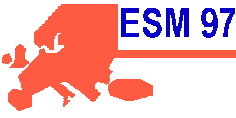
 |
11th European Simulation Multiconference |
![]()
Presentation Overview
Groupware provides a network-based set of flexible software tools that incorporate basic problem-solving techniques such as brainstorming, idea organization, etc. Electronic communications allow all group members, whether distributed or co-located, to make contributions to the group's task both simultaneously and asynchronously. Documented experiences of many organizations attest to increased and greatly reduced completion times in large scale projects. However, groupware has yet to be applied to modelling and simulation (M&S) throughout its life-cycle where it could greatly accelerate progress through active synergistic participation of the various players involved with model development, simulation analysis and implementation. Commercially available simulation tools and methodologies are primarily single-user tools that provide inadequate support for collaborative team-based environments.
This talk presents an architecture to extend advanced M&S capabilities by embedding them in distributed groupware environments. The goal is to enable distributed groups to construct, analyze, validate and implement simulation-based projects in concurrent engineering fashion.
We recognize that collaborative M&S can only be achieved on a solid theory-based foundation. The architecture is thus structured as a set of layers which identify important and separable services culminating in collaboration support at the top layer. Challenges presented by the architecture and progress made will be presented as will potential application domains such as those of business reengineering (BPR) and distributed interactive simulation (DIS).
Simulation: A Technology in Transition
C. Dennis Pegden, Systems Modeling Corporation, USA
Effective Business Systems Engineering
The Contribution of Group Supported Dynamic Modelling
Henk
G. Sol, Delft University of Technology
School of Systems Engineering, Policy Analysis and Management
P.O. Box 5015, 2600 GA Delft, The Netherlands
phone: +31.15.278-7179 fax: +31.15.278-3429
e-mail: sol@sepa.tudelft.nl
Keywords: GSS, group modelling, simulation, animation, business engineering, business process reengineering
Presentation overview:
Dynamism is an inherent characteristic of the environment surrounding modern organizations. Consequently, organizations are forced to adapt their processes, structures, and technologies. The intrinsic character of these change efforts sets the requirements for involving groups of stakeholders and subject matter experts in change processes. Experiences show that both the quality and the productivity of participative change efforts can be enhanced by using electronic meeting and modelling support on the one hand, and simulation and animation techniques on the other hand. This presentation focuses on a business engineering approach that integrates GSS and simulation modelling into a support environment that allows for the participative modelling and design of organizational structures and processes. This approach has been successfully used in a substantial number of industry and governmental organizations.
Modeling Failure Dependencies in
Reliability Models using Stochastic Petri Nets
Ricardo Fricks and Kishor Trivedi
Presentation overview:
Simulation is well-recognized among its expert practitioners as a manufacturing productivity improvement tool. Achievements of simulation in reducing operating costs, increasing production quotas, reducing work-in-process inventories, eliminating bottlenecks cost-effectively, achieving efficiency of scheduling procedures, and otherwise improving performance metrics are well-known among simulation experts and well-documented in the technical literature.
However, within many companies, simulation is used only in unusual situations and when the need for efficiency improvements has reached a high level of urgency and visibility among managers. This presentation describes procedures for upgrading the use of simulation to the status of "norm"; that is, making the exploitation of simulation's analytical powers a standard, expected step during the design, revision, or operation of a production system.
Specifically, the presentation will discuss:
In summary, the topics discussed in this presentation will guide managers and engineers in using simulation more frequently more effectively to prevent and resolve manufacturing productivity problems, thereby increasing corporate profitability.
(c) SCS Europe, 1997. Authors: Ali Riza Kaylan, Alexander Verbraeck, SCS Europe Office. Last change: 03-02-03